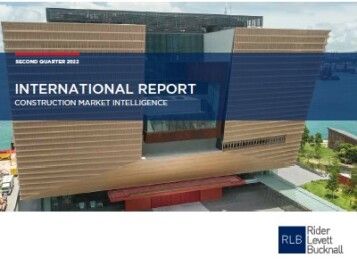According to the Rider Levett Bucknall (RLB) 2nd Quarter 2022 International Report, Australia’s construction industry is in a positive phase.
This is based on the current volumes of work in Q1 2022 and increasing values of work yet to be done and commencements in the majority of states. It is likely that volumes of work will remain at 2021 levels during 2022, and into the first half of 2023.
RLB’s Oceania Director, Research and Development, Domenic Schiafone said, “RLB is seeing significant construction activity in road, rail, health, and social and affordable housing projects, aided by significant investment by all state governments.”
Labour shortages continue due to pandemic
“Fragmented supply chain issues are still not resolved. These are impacting both the timing and cost of building materials and equipment. Labour shortages across the nation continue as a result of the pandemic,” he said.
The federal election and some state elections that have already occurred or are planned in late 2022 early 2023, will impact public sector investment, albeit at the long-term cost of ever-increasing account deficits through election spending promises.
According to the RLB International Report, the economic cost of the recent flood damage on the eastern seaboard is yet to be completely quantified. However, the need for construction labour and materials will only enhance the existing shortages across the country.
Effects of Ukraine conflict to linger
The conflict in the Ukraine continues to cause worldwide unrest, generating sweeping effects on global markets – to which Australia is not immune. Higher fuel prices, increasing power costs, and timber shortages are all symptoms of the conflict, and are likely to linger for some time yet.
Additionally, the continuing zero COVID-19 policy, and associated lockdowns in key trading regions, adopted by China is impacting factory production and supply interruptions.
Construction cost factors remain prevalent
Pressure and volatility on contractor tender pricing continues across Australia. Factors that influenced pricing in 2021 have remained prevalent and pressure increased in the first half of 2022.
Mr Schiafone continued, “Head contractors have reported volatile pricing from the subcontract market, difficulty in pinning down pricing, and sub-contractors being selective in providing tenders, as many are at capacity or unable to secure labour.”
“Supply chain instability, shipping costs and the battle to secure appropriate levels of skilled labour are also all set to remain constant obstacles to the industry as we see out 2022, and move into 2023,” he added.
Surges in tender pricing across all states
Significant surges in tender pricing have been experienced in all states, where escalation uplifts for 2022 are well above levels forecast in the last publication. Suppliers are unable to hold pricing and guarantee availability when tendering. While material price increases have been a risk contractors and subcontractors historically managed, tenders are specifying supply rates for key materials as a condition of tender pricing, resulting in “rise and fall” price adjustment mechanisms being considered and negotiated into contracts.
Aided by rising interest rates, activity forecast to slow
Looking forward, with falling levels of approvals and the issues surrounding current cost increases, supply chain uncertainties and labour availability will potentially see activity slow to some extent, aided by rising interest rates from the Reserve Bank of Australia (RBA) and the forecast general slowdown of the economy.
Looking at construction costs across the country for 2022, RLB is forecasting the following increases: Adelaide (4.8%), Brisbane (10.5%), Canberra (5.0%), Darwin (4.0%), Gold Coast (11.5%), Melbourne (8.0%), Perth (9.0%), Sydney (6.9%) and Townsville (12.6%.)
FURTHER INFORMATION:



